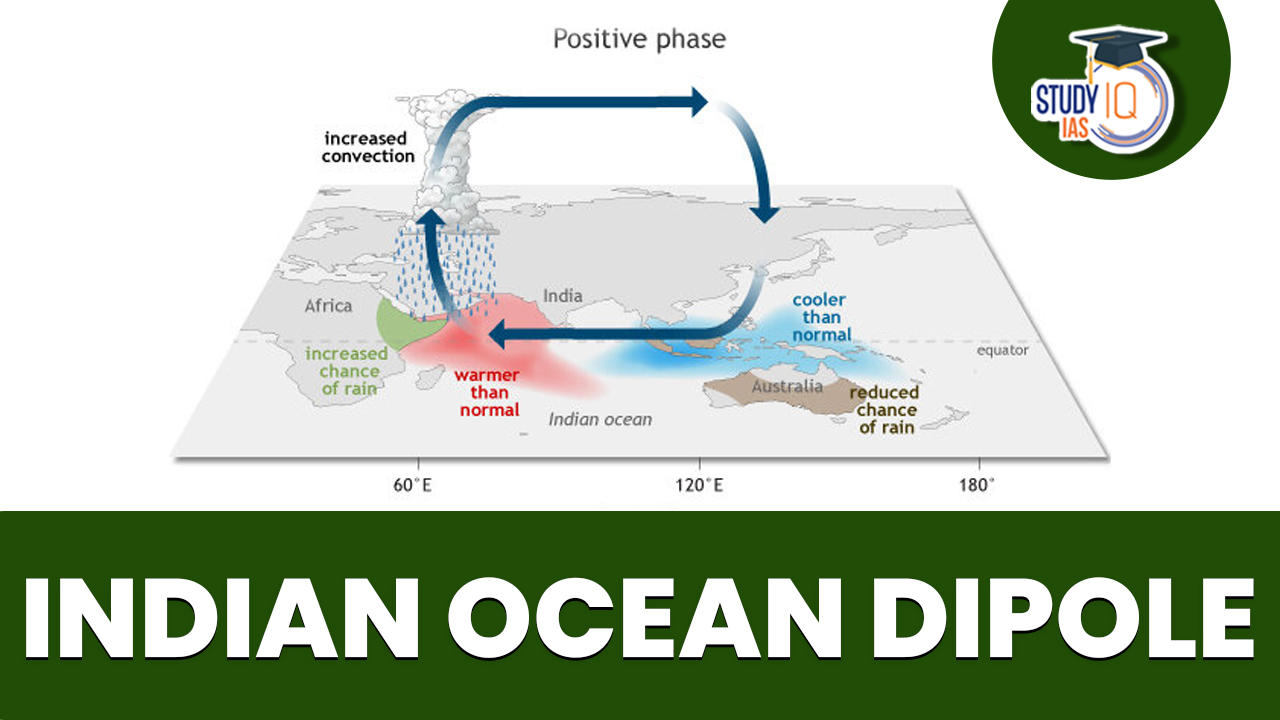Table of Contents
Context: Alongside expecting El Niño, which can harm the monsoon in the coming months, the Indian Ocean Dipole (IOD) has been observed to have undergone a significant change that could also affect the weather.
What is Indian Ocean Dipole (IOD)?
- The Indian Ocean Dipole (IOD) is an ocean-atmosphere phenomenon that occurs in the Indian Ocean.
- It is characterized by the fluctuation of sea surface temperatures and atmospheric pressure patterns between the eastern (Bay of Bengal) and the western Indian Ocean (Arabian Sea).
- The IOD can significantly impact weather patterns and climate in the surrounding regions, including parts of Africa, Southeast Asia, and Australia.
- The IOD is defined by the Dipole Mode Index (DMI), which is a measure of the anomalous sea surface temperature (SST) gradient between the western equatorial Indian Ocean and the southeastern equatorial Indian Ocean.

Link between IOD and ENSO
- The Indian Ocean Dipole can be thought of as the Indian Ocean basin branch of the Walker Cell, which in turn, is associated with the El Niño Southern Oscillation (ENSO).
- ENSO is an irregular periodic variation in winds and sea surface temperatures over the tropical eastern Pacific Ocean, affecting the climate of much of the tropics and subtropics.
- The longitudinal (east-west) circulation across the equatorial Pacific is known as the Walker cell or Walker circulation.
- Changes in ocean temperatures western Indian Ocean and eastern Indian Ocean (i.e., the dipole) drive convection and alter the Walker Cell circulation.
- The link between IOD and ENSO is often exhibited in the following ways:
- It is observed that, positive IOD events are often associated with El Niño and negative events with La Niña.
- When the IOD and ENSO are in phase the impacts of El Niño and La Niña events are often most extreme over Australia, while when they are out of phase the impacts of El Niño and La Niña events can be diminished.
Mechanism of IOD
- The IOD has three phases such as Neutral, Positive and Negative IOD.
Neutral Phase
- The neutral phase of the Indian Ocean Dipole (IOD) refers to a condition when there is no significant difference in sea surface temperatures (SSTs) between the western and eastern parts of the Indian Ocean.
- In a normal year, driven by the Walker Cell, the warmer waters in the western Pacific near Indonesia cross over into the Indian Ocean and make that part of the Indian Ocean slightly warmer. That causes the air to raise above this area and falls over the western half of the Indian Ocean basin.

Negative IOD
- The negative phase of the IOD is driven by cooler than normal SSTs off the coast of Africa and warmer than normal SSTs to the west of Indonesia.
- This configuration of surface sea temperatures gives the normal circulation a boost, strengthening the Walker cell. Hence, negative IOD is often associated with La Niña.
- Impacts of negative IOD:
- The stronger circulation brings more consistent westerly winds over the ocean, stronger convection over Indonesia, and often drought conditions for the Horn of Africa.

Positive IOD

Impact of IOD on South West Monsson
- Increased rainfall due to positive IOD: There is no established correlation between Indian summer monsoon rainfall and IOD. But studies have shown that a positive IOD year sees more than normal rainfall over central India. It was demonstrated that a positive IOD index often negated the effect of El Niño, resulting in increased Monsoon rains.
- Droughts Due to negative IOD: A negative IOD, on the other hand, complements El Niño leading to severe droughts.
- Cyclones: At the same time, positive IOD results in more cyclones than usual in Arabian Sea. Negative IOD results in stronger than usual cyclogenesis (Formation of Tropical Cyclones) in the Bay of Bengal. Cyclogenesis in Arabian Sea is suppressed during this time.


 HPPSC Calendar 2024, Check Out Tentetive...
HPPSC Calendar 2024, Check Out Tentetive...
 List Of Tribal Festivals In India
List Of Tribal Festivals In India
 UKPSC Exam Date 2024, Check PCS Notifica...
UKPSC Exam Date 2024, Check PCS Notifica...

















